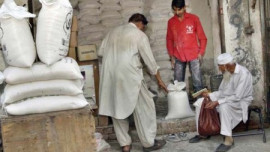
The culture department in collaboration with the Endowment Fund Trust for the Preservation of the Heritage of Sindh is likely to start repair work on these sites, said Hamid Akhund, chief of EFT, while talking to The Express Tribune during a visit to the sites last week.
A number of stakeholders, including archaeological experts, were invited to inspect the sites.
However, he said it is hard to predict the estimated time in which they will be restored.
15 mosques that perfectly capture Pakistan's architectural heritage
Jam Nizamuddin's tomb
The structure of the 500-year-old tomb is tilting towards its eastern side, giving way to the loosening of stones and appearance of inward cracks. It has been said that the appearance of cracks is due to the movements in the foundations of the tomb.
Over the years, several interventions have been carried out to stabilise the leaning structure. One such intervention was the construction of 15 foot high restraining walls in the 1990s, but it has seemingly done little to stabilise it.
Some four years ago, a subsoil investigation was carried out to identify the roots of the structural movement. "The deferential value has been eight inches over the years, as it was revealed four years ago," said Jamshed Danish, a geotechnical engineer, who accompanied the group.
Experts suggested that the cracks have to be filled in immediately. "A solution to support the existing foundation is possible through a construction survey," said Sohail Kibria, another expert.
Heritage: US Consul General visits Hiran Minar
Canopy of Jam Tamachi's tomb
A gush of sandy wind greets visitors as they move a few spaces away towards the tomb of Jam Tamachi and stand under its canopy. The canopy is supported by heavy, iron girdles from the right side. "The graves of the rulers here are as much as 600 years old," said Mohan Lal, a project director at EFT. Kibria suggested a geophysical method for determining the makeup of the foundation while others pointed out that since the issue was of lateral support for the canopy, the foundation's details do not matter.
Shaikh Hamad Jamali Masjid
Shaikh Hamad Jamali Masjid is also supported with girds and wooden buttresses as high as 27 feet. "This mosque is by far in the most precarious condition," laments Lal. The roof was originally supported by three arches, serving well both its aesthetics and engineering.
A number of koels sit in the nooks of the remaining roof and chirp in the summer heat, perhaps warning visitors to be careful as the only remaining arch is in no shape to hold its ground either.
"The foundation stone has lost mortar due to erosion," said Lal. It was also said that stones are loosening out due to the structure's tendency of absorbing rainwater.
Kibria cautioned that the structure has to be saved from both rain and the sun, suggesting that a canopy or shade could be constructed to ward off extreme weather effects.
Tomb of Mirza Isa Khan Tarkhan II
Here reside the rulers and saints of the 14th and 15th century. One can see marks of a water trail in the burial chambers while the erected columns, located in the rear, are tilting to one side.
"The white lines inside the burial chambers are evidence of the effect of water on the sand and salt in construction," said Mohan.
Another expert identified the problem around the calligraphic graves in the courtyard where water accumulates after rainfall. "The platform has no slope. There is no way for the water to drain itself out of the platform," remarked a local guide.
The plan
Among other problems identified around the Makli graveyard was that of encroachments and construction of boundaries to claim land as personal properties. A complete topographical survey of the area to determine the ups and downs and the causes of distresses was agreed upon by the experts.
"The geotechnical survey, planning and designing for the three sites excluding Isa Khan Tomb is likely to be completed within three months," said Mohan.
Lab construction
EFT has also announced the construction of a lab for a historical mortar analysis of the sites near Makli gym. "The owner is the culture department, we are only executing it," clarified Lal. According to him, a facility for wet chemical analysis will be set up in a week while that of a thin section analysis can take up to six months to be set up.
Published in The Express Tribune, May 8th, 2016.


















COMMENTS
Comments are moderated and generally will be posted if they are on-topic and not abusive.
For more information, please see our Comments FAQ